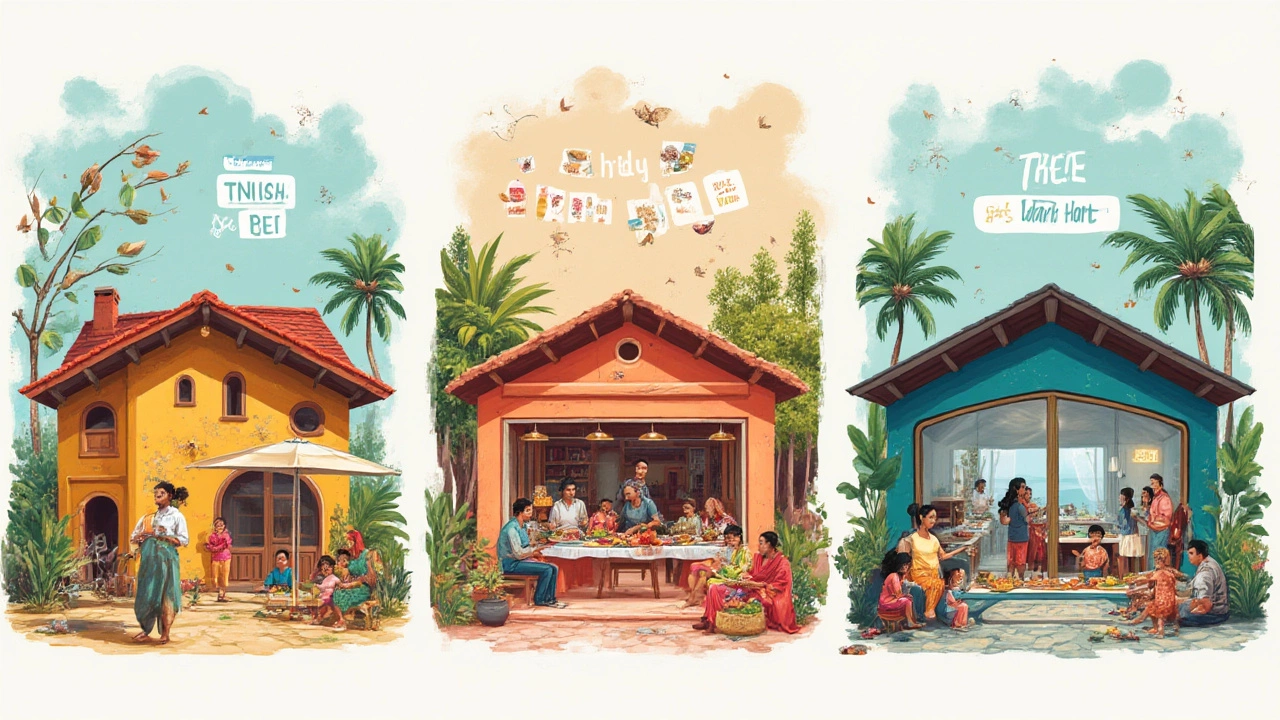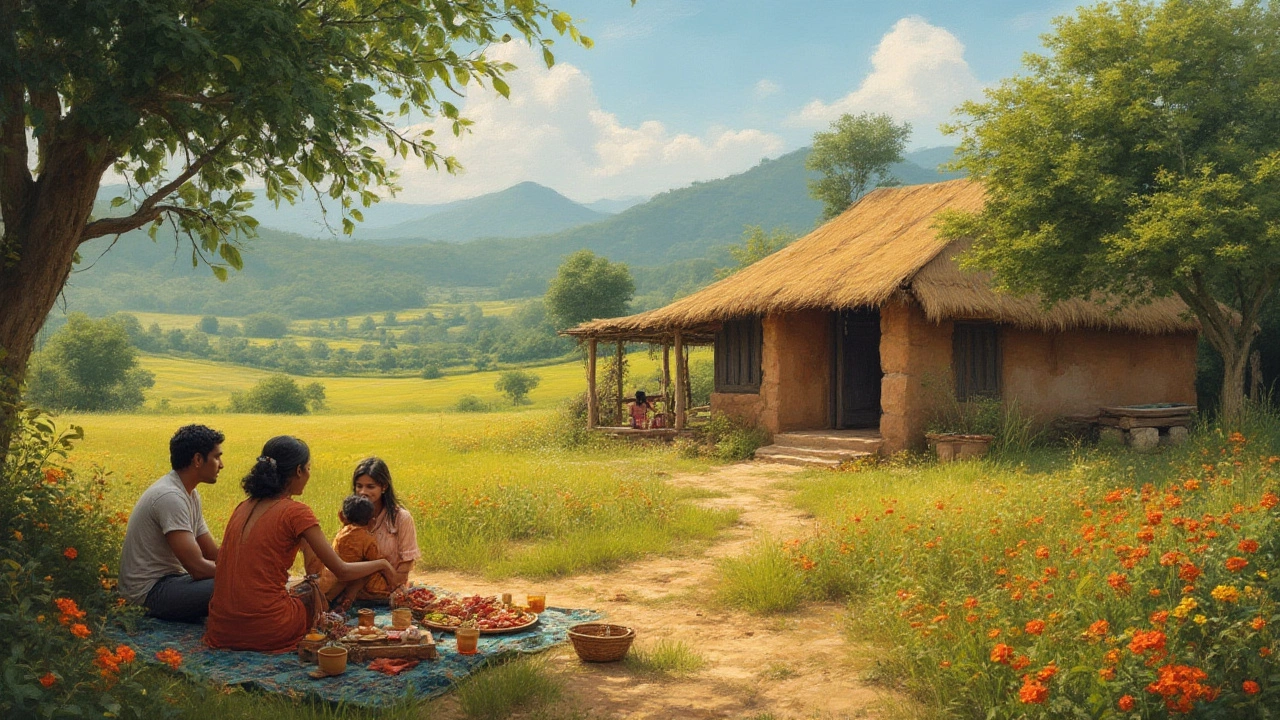Does the idea of waking up on your schedule, without someone knocking on your door for housekeeping, sound like a dream? That’s why so many people pick self-catering accommodation over hotels these days. The whole set-up is about freedom: you choose what to eat for breakfast, you come and go when you like, and no one will give you a side-eye for wearing pajamas at 2 pm. But when you start looking for places to stay, it’s easy to get lost between cottages, apartments, villas, and all those filtered photos of “holiday rentals.” Thing is, each type has its own flavor. Some feel like home, others give you total privacy, and some throw you right in the middle of buzzing cities. Let me clear up what matters most about the three main types, so you can pick the one that actually matches your holiday vibe.
Country Cottages: Cozy Escapes and Countryside Living
The classic self-catering pick—country cottages—never go out of style. I’m a massive fan, honestly, and not just for the peace and quiet. There’s something unbeatable about having your own little home in a rural patch, especially when you wake up to the sound of real birds (not just traffic disguised as birds, like at my apartment in the city). Cottages used to mean tiny, poky places with creaky floors, but that’s ancient history. Now you’ll spot everything from rustic old farmhouses to fancy stone-built stays with underfloor heating and outdoor hot tubs.
Let’s talk location. Most UK cottages—think Cornwall, Lake District, or the Scottish Highlands—are close to hiking trails, country pubs, “pick your own” fruit farms or little villages that seem to have slept through the last century. Some even come with a garden or a patch of woodland, good for kids or, in our case, a dog who treats every stick as a life-or-death discovery.
Amenities can be a mixed bag. You’ll usually get a kitchen with decent gadgets (hello, dishwasher—no one wants to wash bowls on holiday), a living room (sometimes with a log fire), and one or more bedrooms. Some hosts provide a welcome hamper. Don’t expect a 24-hour concierge, but you often find handy guides or even WhatsApp support from the owners who, let’s face it, know the local takeaway scene better than Google does.
Cottages tend to be older buildings, so mind the low beams if you’re tall. Good tip: check if there’s proper heating, especially if you’re booking outside of July or August. Some places still use old-school radiators that creak like haunted house doors. If you’re traveling as a group, you can find places with multiple bedrooms, games rooms, and big gardens—perfect for an extended family trip or, as we once tried, a reunion that ended in muddy wellies and way too much lasagna.
As for value, you save tons by cooking for yourself and shopping at local farm stores instead of eating out for every meal. There are some real quirky extras out there, too—a cottage converted from a train station, an eco-cabin powered by solar panels, or even a lighthouse keeper’s house. A research group found that over 60% of British countryside getaways now offer free Wi-Fi, which is big if you’re hoping to stream movies after a day of walking. But, rural broadband is sometimes, well, rural. So pack board games or download your favorites before the trip.
If you want a mix of privacy, wildlife, comfort, and that homely feel, a cottage will always be tough to beat for self-catering. Many websites now allow you to filter for features like enclosed gardens for pets, log burners, or accessibility features, which didn’t exist a few years ago. I’ll add this—there’s nothing like homemade scones with cream on your own patio, smugly looking at the clouds rolling over the woods. Don’t ask me why, but in a cottage, even burnt toast feels like a treat.

Apartments: Urban Adventures and City Break Convenience
If you love being in the thick of things—cafes downstairs, museums around the block, and public transport within arm’s reach—apartments are the way to go. Self-catering apartments are at their best in bustling cities. Think Paris, Barcelona, London, or even right in the middle of Dublin. Unlike a country cottage, these spaces put you close to nightlife, shopping, galleries, and everything else that makes a city break tick.
One thing you’ll notice: apartments come in all shapes and sizes. Some are basic studios with a tiny kitchenette; others are two-bed penthouses with skyline views. Most modern city rentals are equipped with fast Wi-Fi (usually faster than country Wi-Fi, unless it’s some ultra-remote spot). The kitchen will probably have a hob, microwave, fridge, and enough tools to avoid takeout if you fancy cooking. There are even some that come with laundry machines—great for longer stays or if you have kids prone to sticky situations. A comfortable living area and separate bedrooms are the norm, unless it’s a super-condensed city like Tokyo, where space is a premium.
One underrated perk? Being able to shop like a local. Grab groceries in a corner market, chat to shopkeepers, lug it all “home,” and try to cook a regional specialty. That’s an experience hotels can’t touch, and it’s often one of those little adventures that stick with you beyond the Instagram stories. My wife, Aisling, swears by stocking up at the market in the morning and making paella from scratch in Barcelona, even if the final result is more ‘special’ than it is ‘spectacular.’
Another bonus — noise protection. With your own apartment, you’re not waking up to random people stomping down hotel hallways at 2 am. Most city apartments have better soundproofing than people expect, though it never hurts to check reviews for “thin walls.” Speaking of checks, most apartments offer online check-ins with digital codes, so you can rock up late after a long train ride without hunting for a key under a flowerpot.
The social side varies. If you want complete privacy, go for a whole apartment. But if you’re open to meeting new people, there are aparthotels or serviced flats that mix the apartment’s freedom with hotel-like services—think on-site security, cleaning, and reception desks. That said, apartments typically mean you’re on your own for breakfast (unless you order it in), and you don’t get daily linen changes unless you ask (and sometimes pay extra).
Price-wise, apartments often beat hotels when you’re staying more than a couple of nights. According to a 2024 travel report from Statista, families can save up to 35% by picking an apartment over two hotel rooms, especially in cities like Amsterdam and Prague. Want to make the most of it? Book early for festivals, double-check public transport links, and make a little list of cool bakeries, coffee shops, or quirky museums nearby. You’ll blend in like a local—or at least look like you know what you’re doing.
Let’s talk about some city rental extras: rooftop gardens, pools, or balconies with city views. Some places even offer parking (a game-changer if you’re bringing a car) or gym access. Don’t forget cleaning up after yourself. Few things kill the last-day buzz like realizing you need to empty bins or run the dishwasher before checkout. Pro tip: pack extra bags for separating laundry or snacks, and always screenshot entry codes—they’re surprisingly easy to lose in email clutter.
| Type | Key Perks | Typical Locations | Stuff to Double-Check |
|---|---|---|---|
| Cottage | Privacy, nature, gardens, pet-friendly | Countryside, small villages | Heating, Wi-Fi, access roads |
| Apartment | Central, close to sights, modern amenities | Cities, urban spots | Noise, parking, elevator (if upper floor) |
| Villa | Space, private pool/garden, luxury | Coastal, holiday resorts | Air con, security, transport to shops |

Villas: Room to Roam and Serious Holiday Vibes
If you imagine holidays with a sun-baked terrace, private pool, and plenty of space for everyone, villas check every box. While the word “villa” can sound fancy, you’ll find all kinds—modest bungalows to sprawling luxury homes. The magic is the freedom. Unlike a hotel, you’re not jostling for a pool lounger. You can have pool parties, BBQ every meal, and no one blinks twice if you spend the whole day in your swimmers.
Most villas are found in resort towns—the Algarve, Greek islands, Italian or French coasts, even inland Spain or Croatia. You’ll get more space than with either cottages or apartments, which is brilliant if you’re with family or friends. Think multiple bedrooms (sometimes four or more), huge kitchens with everything you need, big living rooms, and gardens that swallow up a football match with ease. Private pools are common—in a recent survey, 7 out of 10 holidaymakers said a pool was their top villa must-have. Fancy extras? Some places have pizza ovens, game rooms, or roof terraces perfect for sundowners.
With a villa, you’ll notice the vibe changes as soon as you arrive. It feels less like borrowing someone’s small apartment and more like house-sitting for a friend—who happens to own a place with lemon trees and views for miles. You can host big family dinners, lazy brunches, and let the kids run wild. Since villas are usually further from city centers, you’ll probably want a car. Some are tucked into hills or olive groves, so it pays to double-check driving directions or find out if taxis serve the area regularly.
The kitchen tends to be enormous, and you’re likely to find everything from juicers to six-slice toasters (the first breakfast with a full house can get competitive fast). Villas may include things like washing machines, air con, satellite TV, and sometimes even a cleaner who pops in mid-week. One catch: bigger homes mean more to look after. Most owners expect you to tidy up after yourself, and sometimes there’s a “leave-it-as-you-found-it” policy.
Bookings can fill up months in advance, especially around school holidays. It’s normal to split the cost among a group, which makes luxury stays surprisingly affordable—much less than booking several hotel rooms. A 2024 European travel review said families can save up to 40% on their total stay by renting a villa in Tuscany rather than splitting across two nearby hotels.
Safety tip: check if there’s a gated entrance or alarm system, particularly for remote locations. If you’re not used to driving abroad, look up the nearest supermarket or pharmacy ahead of time and keep emergency contacts handy. Pools are brilliant, but if you have small kids, double-check fencing.
Sustainability is a rising trend with villas. Many now offer solar heating, eco-friendly cleaning supplies, and even vegetable gardens. You might come across hosts who give you a tour of the property, sharing where to pick lemons or collect eggs in the morning (yes, it’s as much fun as it sounds). Want to live large? Some luxury places offer private chefs or in-house spa treatments for the day you want to completely switch off.
Last tip: Pack those almost-forgotten kitchen staples (tea, olive oil, garlic salt). International villa pantries never stock what you expect, and after a long day swimming, the last thing you want is a midnight spaghetti disaster because you can’t find oregano. For families, villas with games, bikes, or outdoor play areas are golden. You don’t need to plan activities for every minute—the space gives you room to just be, which is really the whole holiday point.
If you’re picking your next escape, remember: self-catering isn’t a compromise—it’s a leap into your own rhythm, whether you’re soaking up quiet in a country cottage, getting a taste for city life in a smart apartment, or spreading out in a sun-drenched villa. Each one is brilliant in its own way—choose the one that fits your mood, your crew, and how you want to wake up on holiday. Less structure, more room for you. That’s hard to argue with.
